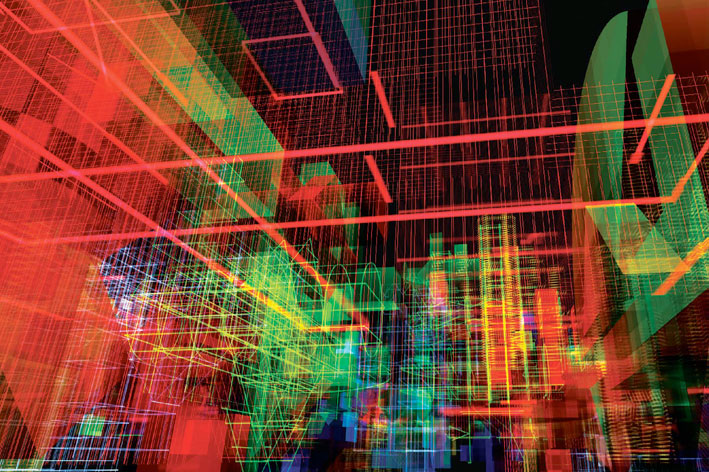index / artistes / miami gallery


|
'Power Pixels 2016' is the first solo exhibition of Miguel Chevalier As a pioneer of digital art, Miguel Chevalier has been using information as a way of expression in the field of art since 1978. His work addresses the question of immateriality in art by using the logic of computers, such as hybridisation, interactivity and generativity. Presented in this exhibition is a series of digital installations as well as fixed works, both recent as well as older, which explore themes of the city and urban transformation. With these works, the artist helps to renew and refresh our ideas of the city and its architecture, thus reinventing the city of tomorrow and reimagening our future world. In response to the evolution of city development and globalisation, the fixed works presented for the exhibition are a selection of previous works developed during the 90s and 2000s (Aller/Retour – Tokyo/Kyoto, Villa Kujoyama, 1996 ; Périphérie, Espace Cardin, Paris, 1998 ; Mémoire et Mutations, La Fabrique, Beyrouth, 1999 ; Metapolis, Marco, Monterrey, Mexico, 2002). The two digital works, 'Méta-cités 4' 2015 and 'Méta-Cités Filaire' 2016, presented on LCD screens, show two different virtual cities which are inspired by cities and urban spaces in megacities. In 19th century, Cerda, Haussmann and Otto Wagner elaborated on urban models capable of restructuring the city and reorganising traffic systems, however nowadays, drastically increased traffic flow and live information exchange oblige us to think of the city in another way when it comes to its relation with life and territory. Using digital tools we are now able to explore these new digital cities and their position in the world. As global cities, with no locale, no starting or ending point, no center or outskirts, 'Méta-cités' are two virtual metropoles consisting of wireframe buildings which parade before our eyes. These cities are generated by computer software written by programmer Claude Micheli. The cites generate a chaos of dynamism and flux which would be itself non-programmable. They are indictive of the generic city1 which reproduces without spirit, landmark or individuality. This virtual city projects us into a space where nature disappears in favor of an unstoppable urbanism and where cities join together indefinitely. Meta-Cities is no longer just a tangle of networks, it is imposible to know as a whole, a virtual city which we can only understand by way of a spatial model. In a way “Meta-Cities” is a generator of urban utopias, of cyberspace architecture. In parallel with these two creations, a series of fixed works made using laser cutting techniques and 3D printing will also be presented. Among these works are three sculptures in plexiglass, 'Méta-cités 1', 'Pixels Archi-sculpture', and 'Archi-Pixels' which were realised using laser cutting techniques to materialise imaginary architectures. A virtual aesthetic emerges, mixing materials and pixels. The artist becomes a sculpter of the virtual. A series of digital prints in colour or black and white, from the universe of 'Méta-cités' complete the exhibition. The series 'Méta-cités - White and Black' is a hommage to the nucleus of a digital work : the pixel. The elementary point of all digital images, the pixel is a recurring motif in the work of the artist and his research in digital art. It is for him the equivalent of the pictoral touch. If Roy Lichtenstein, Richard Hamilton or Alain Jacquet were interested in the augmentation of the point and the offset of patterns, Migual Chevalier is developping a language founded not on the pattern between points like these artists but on the pattern between pixels.The pixel, expanded, moving or fixed, becomes independant and composes abstact graphic universes, rich with poetry. These pixels are also the image of Big Date, that is to say, the trillions of bytes of data which are generated each day : messages on social media sites, digital images and videos published online, transaction records of online purchases, GPS or phone signals... This is the metaphorical image of the quantitative explosion of digital data that forced us to create new ways to store data and to see and analyse the world differently, as is symbolised with the work "Cyberspace Pixels". Through the theme of the city, the exhibition shows how the artist can transpose a form of reality into a new fantasy. These creations generate tangible worlds that open new and poetic horizons capable of raising emotions. It invites us to read and experience the city in a whole different way. With these digital works, Miguel Chevalier captures and transcribes the elusiveness of these new forms of contemporary city life: relentlessly renewing, accellerating transformation. Leaving out all chronological and linear memory, he constructs with images an urban “time constellation”, somewhere between construction and destruction, growth and mutation. Light, movement, energy: these are the new poetics of materiality developed in the lineage of the kinetic works of Julio Le Park, François Morellet, works which Gallery Mordoch has been closely followed and exposed for the past 20 years. Miguel Chevalier borrows from this aesthetic the concepts of flows and networks. Making the invisible visible and revealing the essence of things in a world which is constantly changing. 1 Generic City theory by architect Rem Koolhaas |
|